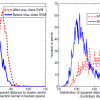23 search results - page 1 / 5 » Additive Distances and Quasi-Distances Between Words |
JUCS
2002
13 years 4 months ago
2002
: We study additive distances and quasi-distances between words. We show that every additive distance is finite. We then prove that every additive quasi-distance is regularity-pres...
MLCW
2005
Springer
13 years 9 months ago
2005
Springer
The Recognizing Textual Entailment System shown here is based on the use of a broad-coverage parser to extract dependency relationships; in addition, WordNet relations are used to ...
ICCV
2009
IEEE
14 years 9 months ago
2009
IEEE
Common visual codebook generation methods used in
a Bag of Visual words model, e.g. k-means or Gaussian
Mixture Model, use the Euclidean distance to cluster features
into visual...
TIT
2008
13 years 4 months ago
2008
The term binary combinatorial Gray code refers to a list of binary words such that the Hamming distance between two neighboring words is one and the list satisfies some additional ...
CORR
2010
Springer
13 years 4 months ago
2010
Springer
While Kolmogorov complexity is the accepted absolute measure of information content in an individual finite object, a similarly absolute notion is needed for the information distan...

